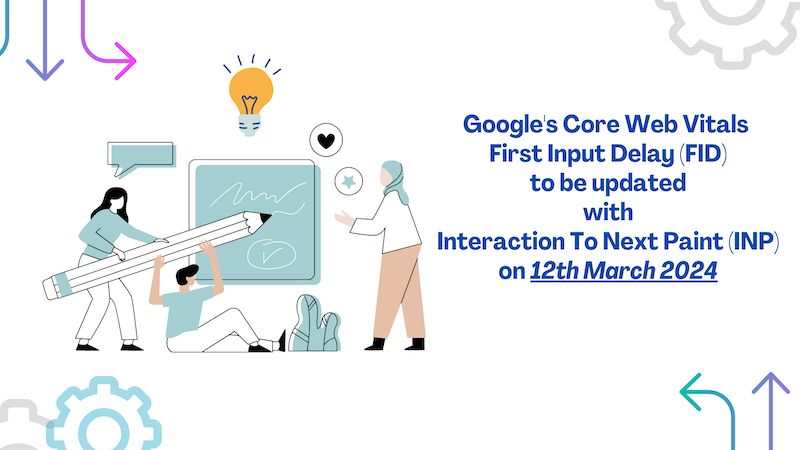In the dynamic world of the internet, where user experience reigns supreme, Google consistently shapes the digital landscape through algorithmic updates. The anticipation is palpable as we approach March 12, the date earmarked for Google's latest Core Web Vitals update, with a significant replacement of First Input Delay (FID) with Interaction To Next Paint (INP). Let’s explore the intricacies of the Core Web Vitals update, focusing on the groundbreaking INP metric and its potential impact on web development, SEO, and user engagement.
Understanding Core Web Vitals:
Before delving into the specifics of INP, let's recap the existing Core Web Vitals. Introduced by Google in 2020, these vitals comprise three key metrics: Largest Contentful Paint (LCP), Cumulative Layout Shift (CLS), and First Input Delay (FID). LCP gauges loading performance, CLS assesses visual stability, and FID measures interactivity – all crucial elements contributing to the overall user experience.
The Evolution of Core Web Vitals with INP:
Interaction To Next Paint (INP) is Google's response to the ever-growing need for a more nuanced evaluation of user interaction on websites. It centers on minimizing the time lapse between a user's input (such as clicking a button) and the subsequent visual response – the next paint on the screen. Recognizing the paramount importance of a seamless and responsive user interaction, Google aims to raise the bar with the introduction of INP.
INP Technical Deep Dive:
To grasp the full extent of INP, it's essential to delve into the technical aspects that underpin this metric. Developers and website owners must consider a multifaceted approach to optimization:
JavaScript Efficiency: INP relies heavily on the swift execution of JavaScript. Developers should conduct a thorough review, identifying and optimizing resource-intensive functions that may impede responsiveness.
Network and Server Optimization: The delay between user input and server response directly influences INP. Optimizing server responses and minimizing network latency, potentially through content delivery network (CDN) implementation, can significantly enhance interaction responsiveness.
Critical Rendering Path Streamlining: A streamlined Critical Rendering Path (CRP) is pivotal for the rapid rendering of the user interface. Minimizing render-blocking resources, prioritizing above-the-fold content, and leveraging asynchronous loading techniques contribute to overall page responsiveness.
Resource Loading Optimization: Efficient loading of resources, including images, CSS, and fonts, plays a crucial role in INP optimization. Techniques like lazy loading and asynchronous loading ensure progressive resource loading, prioritizing those essential for the initial user interaction.
Browser Compatibility and Feature Policies: Ensuring cross-browser compatibility and appropriate feature policy configurations is vital. This guarantees a consistent and smooth user experience across diverse platforms.
Tools for INP Optimization:
PageSpeed Insights: Google's PageSpeed Insights provides valuable performance insights, including detailed information on INP. Utilize this tool to identify bottlenecks and receive actionable suggestions for improvement.
Lighthouse: Lighthouse, an open-source automated tool, integrates INP metrics. Conduct Lighthouse audits to receive specific recommendations for enhancing your website's performance, encompassing INP optimization.
Preparing for the March 12th Update:
As the countdown to the Core Web Vitals update with INP continues, website owners and developers must take proactive measures to align with the new standards. Implementing the aforementioned technical optimizations, utilizing tools like PageSpeed Insights and Lighthouse, and staying abreast of Google's guidelines will position websites for success in the post-update era.
SEO Implications:
Google's commitment to user experience is evident in its algorithm updates, and the Core Web Vitals with INP are no exception. Websites that prioritize these metrics are likely to witness positive impacts on search engine rankings. As the search giant emphasizes seamless user experiences, aligning with Core Web Vitals becomes not only a best practice but a strategic move for sustained online visibility.
As we stand on the brink of the Core Web Vitals update with the groundbreaking INP metric, the digital landscape is poised for a transformative shift. Developers and website owners must view this as an opportunity to not only meet Google's evolving standards but also to enhance user experiences and secure a competitive edge in the online arena. The intricate dance between technical optimization, user-centric design, and SEO strategy is the key to unlocking success in the era of Interaction To Next Paint. As March 12 approaches, the digital realm holds its breath, ready to embrace the next phase of web evolution.
February 6, 2024





